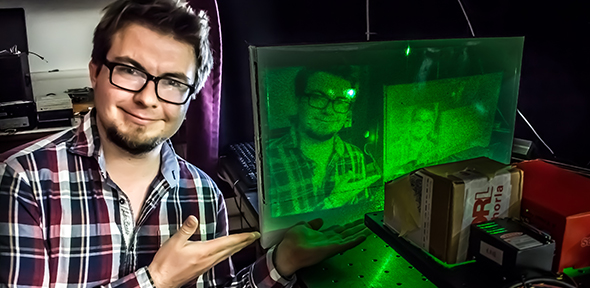
Holographic displays have the power to stop you in your tracks, projecting realistic three-dimensional digital content that floats right in front of your eyes. It is a visual experience that is transforming the way we view, interact and connect with the world around us says alumnus Andrzej Kaczorowski.
Bringing inventions to life is a deeply rewarding experience. I love the whole process, from brainstorming and coming up with an idea to creating the first working prototype that demonstrates functionality not achieved before.
Andrzej Kaczorowski
VividQ, the start-up Andrzej co-founded following his PhD, is delivering these types of realistic and immersive visual experiences to next-generation digital displays. Here Andrzej reveals more about the VividQ story.
I am a technologist and inventor at heart. Bringing inventions to life is a deeply rewarding experience. I love the whole process, from brainstorming and coming up with an idea to creating the first working prototype that demonstrates functionality not achieved before.
The operation of complex devices and systems have fascinated me from a young age. I was fascinated by the inner workings of all the objects surrounding me. That passion was quite unfortunate for my parents, who would often find various household appliances taken to bits. I was successful at taking them apart, but not always at putting them back together. Quite early on, I started showing interest in maths and physics and at the age of 13, began my journey with computer programming. While in high school, my physics teacher encouraged me to explore the topic on my own and I started spending hours in the little school lab. This also motivated my choice of a degree, a BSc in Physics with Computer Science at King’s College London. I finished in the top three of the year. Later on, I pursued the Master of Research (MRes) and a PhD in Photonic Systems Development from the University of Cambridge.

Andrzej is pictured in 2014 with the holographic projector he built during his PhD at Cambridge. Credit: Andrzej Kaczorowski
My PhD laid the groundwork on which VividQ was founded. While in Cambridge, I specialised in computer-generated holography for displays, a topic that brought together multiple passions of mine: programming, computer graphics, digital cameras, automation and algorithm design. My research explored the ways in which computer-generated holography can be improved and implemented in realistic devices such as pico projectors, optical lithography devices and mixed reality headsets. This included improving the quality of the image itself, speeding up the computation of holograms and correcting optical imperfections in the software. During this time, I demonstrated the first real-time high quality holographic projections on off-the-shelf Graphics Processing Units (GPUs), while under the supervision of Professor Tim Wilkinson. Despite the fact that GPUs were developed specifically for computer graphics, researchers like myself learnt to hijack their power for scientific computation. The method I developed in my research offered hologram generation of up to three orders of magnitude faster than the standard method. Towards the end of my degree, I met my co-founders, Dr Darran Milne and Tom Durrant. We were shortly joined by Dr Roman Pechhacker, Aleksandra Pedraszewska (who I know from the Polish Society) and Dr SJ Senanayake, my PhD colleague who I recommended as a great addition to the team. Together, we gave birth to what would then become VividQ.
VividQ is a deep-tech software start-up that is on the path to revolutionising display technology. Our software enables the integration of holographic displays into Augmented Reality (AR) smart glasses, Head-Mounted Displays (HMDs), Head-Up Displays (HUDs) and consumer electronics. Since its inception in 2017, VividQ has grown from six co-founders to more than 40 full-time employees. In July 2021, we closed a new funding round of £11M to establish our vision for the future of display with computer-generated holography.
This year, VividQ has a line-up of exciting advancements. These include “HoloLCD” – a laptop scale holographic display that uses regular LCD (Liquid Crystal Display) panels in combination with VividQ’s innovations to give a complete three-dimensional experience, without the need for glasses. Building upon our focus on AR, we are also implementing what we call "VividQ Alpha" – holographic smart glasses providing immersive content with a large field of view in an ergonomic and consumer friendly package. We will also continue our prototyping activities aimed at holographic Head-Up Displays (HUDs) that will hit the road (pun intended) within the next two to three years.

Credit: VividQ
I am now leading a dedicated research team at VividQ as Chief Scientist. Innovation has always been at the core of what we do. The team I lead is focusing on looking five to 10 years ahead and identifying building blocks of the next-generations of holographic displays. The topics we explore range from nanophotonics and material science, through hologram computing architectures/methods, all the way to realism in computer-generated imagery and media production work flows. I coordinate joint research projects with the University of Cambridge and University College London (UCL) via the Centre for Doctoral Training in Connected Electronic and Photonic Systems; the University of Bournemouth via the Centre for Digital Entertainment; and the University of St Andrews, among others.
I have mentored and coached numerous engineers and researchers and supervised tens of research projects. Seeing people grow and develop gives me a lot of satisfaction and it has been a joy to share my knowledge and expertise in this way. I continue to challenge myself in my spare time by turning my attention to automating my house, learning more about the Internet of Things (IoT) and smart homes in the process.

